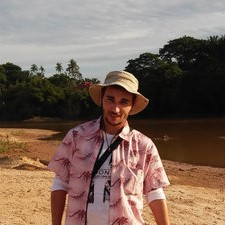
Benjamin Sautter
Thesis defended on March 3rd 2017
at Paris Sciences et Lettres
Earth and Environment Sciences
Influence of pre-existing fabrics in the structures and Evolution of the Rifting : insights from the western margin of Sunda Plate
Abstract
Sedimentary basins often develop above internal zones of former orogenic belts. We hereafter consider the Malay Peninsula (Western Sunda) as a crustal high separating two regions of stretched continental crust; the Andaman/Malacca basins in the western side and the Thai/Malay basins in the east. Several stages of rifting have been documented thanks to extensive geophysical exploration. However, little is known on the correlation between offshore rifted basins and the onshore continental core. In this paper, we explore through mapping and seismic data, how these structures reactivate pre-existing Mesozoic basement heterogeneities. The continental core appears to be relatively undeformed after the Triassic Indosinian orogeny. The thick crustal mega-horst is bounded by complex shear zones (Ranong, Klong Marui and Main Range Batholith Fault Zones) inititiated during the Late Cretaceous/Early Paleogene during a thick-skin transpressional deformation and later reactivated in the Late Paleogene. The extension is localized on the sides of this crustal backbone along a strip where earlier Late Cretaceous deformation is well expressed. To the west, the continental shelf is underlain by three major crustal steps which correspond to wide crustal-scale tilted blocks bounded by deep rooted counter regional normal faults (Mergui Basin). To the east, some pronounced rift systems are also present, with large tilted blocks (Western Thai, Songkhla and Chumphon basins) which may reflect large crustal boudins. In the central domain, the extension is limited to isolated narrow N-S half grabens developed on a thick continental crust, controlled by shallow rooted normal faults, which develop often at the contact between granitoids and the host-rocks. The outer limits of the areas affected by the crustal boudinage mark the boundary toward the large and deeper Andaman basin in the west and the Malay and Pattani basins in the east. At a regional scale, the rifted basins resemble N-S en-echelon structures along large NW-SE shear bands. The rifting is accommodated by large low angle normal faults (LANF) running along crustal morphostructures such as broad folds and Mesozoic batholiths. The deep Andaman, Malay and Pattani basins seem to sit on weaker crust inherited from Gondwana-derived continental blocks (Burma, Sibumasu, and Indochina). The set of narrow elongated basins in the core of the Region (Khien Sa, Krabi, and Malacca basins) suffered from a relatively lesser extension. This work shows that the core of the late Cretaceous Orogeny is weakly reactivated during the subsequent rifting with only few evidences of stretching whereas its sides are thinned with large tilted blocks. The rifting migrates and localizes on the external regions and its geometry appears more ductile suggesting the influence of a thermal activity in the process. The coexistence of both geometries in a single rifting cycle makes the western margin of Sundaland an enlightening example.
Supervisors
Manuel Pubellier
David Menier
President of the jury
Robin Lacassin
Members of the jury
Manuel Pubellier
David Menier
Robin Lacassin
Dominique Frizon de Lamotte
Julia De Sigoyer.
Rapporteurs
Dominique Frizon de Lamotte
Liviu Matenco
Keywords
Rifting
Reactivation of Orogen
Bassins Crétacé / Tertiaire
Granite exhumation
Péninsule Malaise
Sundaland

